WORLD CLASS COACHING
Pre-Season Conditioning
By Alex Trukan
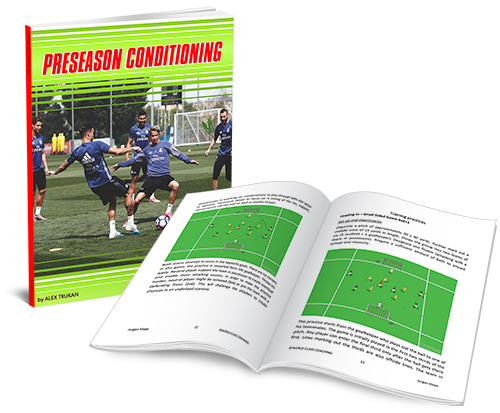
TABLE OF CONTENTS
Part Two
1V1'S FOR POWER
3V3+2 TURNING GAME
2V2 LEAGUE
1V1'S FOR SPEED
1v1’s to Develop Power to Accelerate
Week: 5
This practice is focused on improving maximal explosiveness of the action. It will help players to gain advantage over opposition in running duels and be more powerful in 1v1 battles. Technically, the practice contains a lot of staying on the ball skills, combination play as well as an element of a finish. It can be adapted to include more tactical elements as well whilst working on the conditioning aspect.
Set up and directions
Organise 40 x 40 yards square and a further 8 x 8 yards square in the middle of it. Place a small goal in each of the corner of the big square. Divide the team into two groups of four. First group of four starts outside the square, with one player on each end. The other four get in pairs and assign one defender and one attacker within a pair. Both pairs in the middle need one ball each.

The practice starts with a player on the ball trying to stay on it within small square. The other player from a pair tries to win it back. If he wins it back, he tries to stay on it and don’t give it away.

On a coach’s signal (staying on the ball should not last longer than 5 seconds), whoever is on the ball tries to break out and combine with one of the outside players.
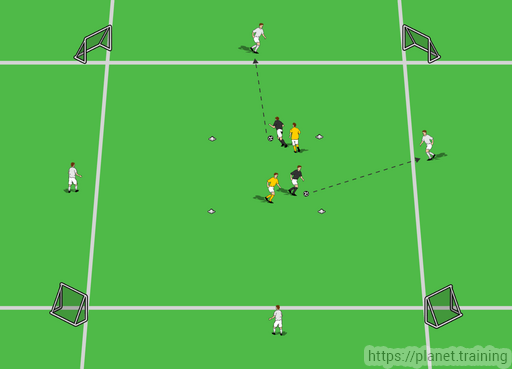
Outside player plays back off one touch to set the finish up into one of the small goals. Finish has to be off one touch as well. After each go, players rotate. Players from the inside swap with the outside players.
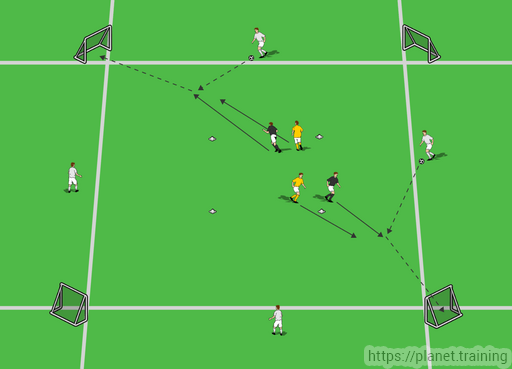
Timing:
Each repetition (staying on the ball plus break out) should last between 5-7 seconds and be repeated 4-6 times in 1-2 series. Ensure maximal effort on each repe tition. Rest between repetitions should be 1 minute (other four working) and between series, 4 minutes.
Variations:
- Outside players play off one touch
- Can’t finish in the nearest goal
- Increase/decrease the size of the area
3v3+2 Turning Game (3v3/4v4)
Week: 5 & 6
This practice is aimed at improving body’s speed of recovery between high intensity actions. Therefore, the quicker ATP (energy) can be returned and available, the quicker a player will be able to produce sprints and maximal bursts again. Main technical component of this practice is turning. This will require players to be good at scanning, combination play as well as recognising and creating spaces. Goals can be also included in the practice what will add finishing element to it and make it more engaging.
Set up and directions
Organise 20 x 30 yards rectangle with two end zones (3 yards long) as shown on the diagram below. Divide the group into two teams of three and two target players. Set target players behind the end zones, one on each end. Remaining six players start in the middle. Prepare a supply of balls next to each target player to ensure flow of the practice.

The practice starts with one of the target players who plays the ball into attacking team (which team is attacking first is decided by the coach). The team in possession then tries to combine and play through to the other side of the area.

The aim of the team is to visit opposite end zone, turn back and play the ball into the same target player from which they got the ball originally. That counts as one point. If the pass back to the target player is not available, they might choose to visit opposite end zone and then play the ball into the other target player. The idea stays the same – visit opposite end zone before passing the ball into the target player.

As a progression, goals might be added. In this scenario as the ball is passed into the target player, he will be looking to play a wall pass and set somebody else to finish in goals off one touch. The game is then restarted from opposite target player.

Timing:
The practice should be played 1-3 minutes and repeated 6-10 times in 2 series. Rest period between repetitions should be 3 to 1 minutes and between series, 4 minutes.
Variations:
- Add goals (various sizes can be used)
- Player that passed the ball into target player can’t score
- 3v3/4v4
2v2 Staying on the Ball League (3v3/4v4)
Week: 5 & 6
This practice is improving body’s speed of recovery between high intensity actions. Thanks to this conditioning component, players will be ready to perform another high intensity action earlier (speed of recovery improved). Technically, the practice is focused on staying on the ball in small teams of two. Players will be challenged to shield the ball, dribble as well as combine in two’s.
Set up and directions
Organise three rectangles of 5 x 10 yards next to each other as shown on the diagram below. Split the group into six teams of two. Assign each team and their opposition into all of the three areas. Each area needs one ball to play plus supply of extra balls next to the pitch.

On a coach’s signal, one team starts on the ball and tries to keep possession of it within their square. When it goes out, pass in or dribble in applies. No sliding tackles allowed. Defending teams should be encouraged to stay on their feet and regain possession cleanly.

Once possession is gained by the opposition, they are looking to stay on the ball as well. The team that finishes in possession of the ball at the end of designated time, wins the game. Winner moves up one pitch, losing team moves down one pitch. Winner in the highest league (pitch) stays and similarly, loser in the lowest league (pitch) stays in his area (promotion/relegation system).

Goals can be added for further competitiveness and used in various ways. For example, if the team manages to make 10 passes without opposition touching the ball, they can score in any of the two goals.

Timing:
Each round of 2v2 should be played for 1-3 minutes and repeated 6-10 times in 2 series. Rest period between repetitions (each round) should be 3 to 1 minutes and between series, 4 minutes.
Variations:
- Add goals
- Increase/decrease the size of the area
- Limit amount of touches/challenge players to take min. 3 touches
1v1’s with Starting Speed
Week: 6
This practice is specifically designed to improve players’ starting speed over short distances (5-10 yards). This is especially important in and around the box and can be a crucial element which determines winners and losers. From technical point of view, the practice includes finishing skills under pressure what links to the real context in which starting speed is often used. This increases players’ motivation and helps to make them work with a maximal effort.
Set up and directions
Organise two starting cones and set up goals 20 yards in front of it as shown on the diagram below. Organisation used below with two goals next to each other is one of the options. Set goalkeepers in goals. Divide the team into pairs and further assign four servers/target players. Two pairs start on each of the two cones. One server goes on each of the cones as well and prepares a good supply of balls. Two target players start 10 yards away from the starting cone facing the server.
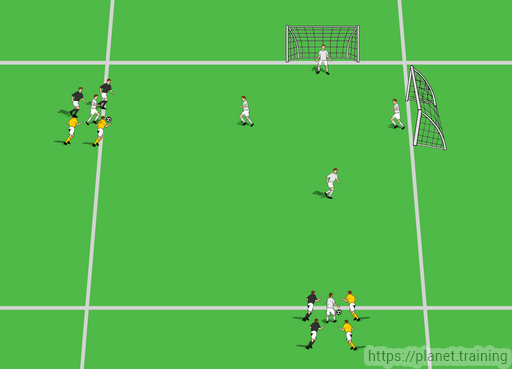
The practice starts with a server passing the ball into the target player. The pass should be of a good quality with appropriate weight and accuracy. At the same time server holds hands of two players not letting them start to early.

Target player stops the ball in front of him on a little angle (right/left). As he touches the ball, both players can start the run into the ball (their hands are released at the same time). Target player has to move away quickly and leave the space for the runners.

First player to the ball has a shot at the goal. No sliding tackles allowed from the player that is delayed. Players should be careful not to injure each other. After each go, pair brings the ball back and comes back to the starting point.
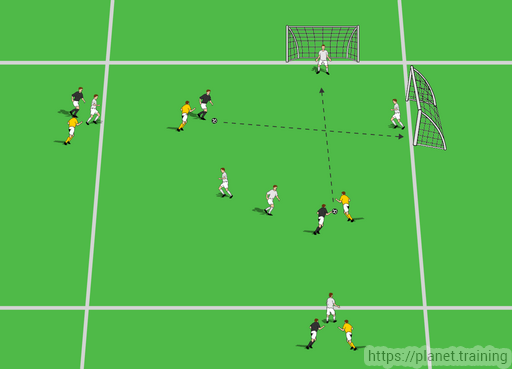
Timing:
Each repetition (running duel) has to last max. 2 seconds. (5-10 yards). Each pair should repeat it 8-10 times in 2-4 series. Rest period between repetitions should be 30 seconds (other pairs working), and between series, 4 minutes.
Variations:
- Ball already stopped 5-10 yards away from the pair, running duel triggered by a coach
- Increase/decrease the distance between ball and starting point (within 5-10 yards)
- Vary sizes and types of goals


